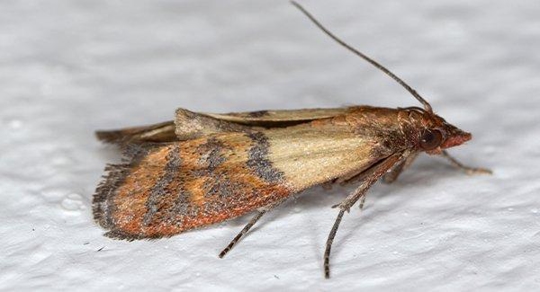It's bad enough when pests get into your home. It's worse when they get into your pantry. Though this is a common occurrence, no one likes to run across pantry moths. Also known as Indian meal moths, these pests are famous for their diet of grains.
Besides locating them in the pantry, you can recognize these pests by the reddish-brown coloring of their forewings. They are also only 5/8 of an inch long at most. When at rest, the pantry moth holds its wings over its body in a roof-like position.
Indian meal moths are found in a wide variety of climates and their larvae live in stored food products, which include grains, dried fruit, seeds, spices, and pet food. In fact, pet food is a common culprit when it comes to identifying the cause of infestation. Since many of these sources go unattended, this can result in an infestation going a long time unnoticed.
How Infestation Starts
Pantry moths can get in your home by hitchhiking their way in on stored food products. They will also come in from the outside. If you see pinkish-white caterpillars crawling in your food items, then you have the beginnings of an infestation.
While it's true these pests dine on the food and spices you have stored away, the fact remains that most of the damage comes from contamination. During their time within your food, they spin silk, which collects discarded skin, eggshells, fecal pellets, and more, over time.
Prevention Tips For Pantry Moths
Like with most pests, it's important to practice good sanitation and food storage to prevent and control pantry moth infestations. Some additional tips to consider include:
- Careful inspection: When bringing food from the grocery store, it's vital to check the packages for white worms. These worms are actually larvae and will grow into adults if left unchecked. If you find the food is contaminated then throw it away.
- Proper timing: If you can't consume or use the food in 2-4 months then don't buy it. This includes pet food in addition to people's food.
- Tightly sealed: Whatever food you're storing needs to be in tightly sealed containers to have a fighting chance. In addition, be sure to refrigerate any flour or meals when the climate is warmer.
- Wipe it down: No crumbs or spills should be ignored. Wipe, mop, sweep, or vacuum any spills immediately.
- Professional control: Ongoing pest control coverage can help you regain control of any existing infestation and prevent future ones from occurring.
Eliminate Pantry Moths With Big Blue Bug Solutions
For over 80 years, our team has been hard at work keeping our customers' homes pest-free. We accomplish by developing programs for all pests: Insects, Rodents, and Wildlife. Our residential program comes with three or more preventative maintenance visits each year. At Big Blue Bug Solutions, we believe in complete service, which is why we come out for free if a pest comes back in between routine visits.
In addition to superior service, we also provide the cleanest service around with our exclusive Blue Glove Service. Without fail, our technicians wear blue gloves and blue booties when entering your home. This ensures we keep your home as clean as we found it. The only difference after our visit is that you're pest-free.

